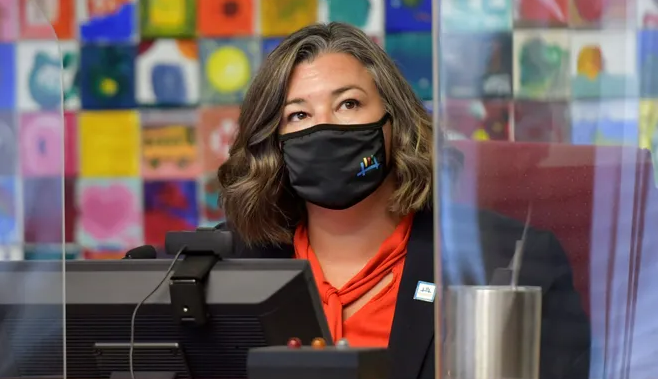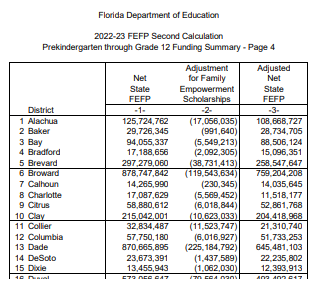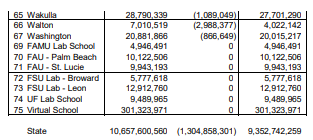
With economic difficulties mounting for Florida’s school districts, budgets are tightening and competition for funds is intensifying.
So is confusion.
Whether intentional or not, something is being lost in translation in education budget reporting. Several recent news stories have featured district officials who are blaming home education, charter schools and, most of all, the Family Empowerment Scholarship, for their budget woes.
Here are some recent examples:
- Leon County Schools will “likely send up to $16 million to local private schools.”
- Volusia County Schools will have a “funding deficit of just over $7 million,” in part, officials say, because the bulk of new funding from the state must go to the Family Empowerment Scholarship.
- Duval County School Board Member Elizabeth Anderson complained that the increase in state funding “will go through voucher programs and our charter schools,” and not be invested in local district schools.
- Pasco County Schools claimed it couldn’t afford desired pay increases because of “the state’s expansion of programs that use public money to pay private school tuition.”
- Polk County Public Schools claimed the scholarships “siphoned off” $14.4 million last year and expected that amount to climb to $49 million this year. “This is an area that you’re going to see a large impact on our budget,” said Heather Jenkins, the district’s CFO.
 Districts point to the table above in the Florida Education Finance Program (FEFP) as evidence they are paying for the scholarships when that money could be funding their own priorities.
Districts point to the table above in the Florida Education Finance Program (FEFP) as evidence they are paying for the scholarships when that money could be funding their own priorities.
That’s not entirely accurate.
First, Florida’s school districts do not pay for private school scholarships through the Family Empowerment Scholarship programs. The state does.
And despite districts’ claim that the money is passing through their hands, not a single penny meant for the scholarships ever reaches district coffers.
The money exists only on this table, and it is intended only to help calculate the scholarship values as required by law.
State law sets the scholarship values at 100% of the unweighted per-pupil funding from the FEFP (minus some funds). This results in different scholarship values varying widely between counties, and even between elementary, middle, and high school grades within each county.
To determine 201 different scholarship values, state analysts place the students and dollars into the counties for calculation purposes only. No district should be budgeting based on the “Net State FEFP” column because that’s not money it will ever receive.
Duval couldn’t invest those dollars back into its public schools any more than Pasco could use FEFP funds to raise teacher salaries. If their students never took a scholarship, the districts might see those students enroll and, if so, the budget would increase. But that money would have to go toward educating the influx of additional students, and that same sum couldn’t be used to also pay for improvements or pay raises.
You just can’t spend the same dollar twice. It’s money, not magic.
What’s more, the scholarship programs use only state FEFP funds and do not touch locally raised support. In other words, districts get fewer students, but they can also keep more local money for each student that remains.
 The state uses a different way to calculate funding for Laboratory Schools and Florida Virtual School (as seen in the chart above). Despite students exiting local public schools, along with the dollars that follow them, funding for Laboratory Schools and Florida Virtual School isn’t shown as “removing” funds from local school districts. Instead, they are funded separately, as if they were their own districts. Functionally, it has a similar impact on district enrollment and budgets as the Family Empowerment Scholarship.
The state uses a different way to calculate funding for Laboratory Schools and Florida Virtual School (as seen in the chart above). Despite students exiting local public schools, along with the dollars that follow them, funding for Laboratory Schools and Florida Virtual School isn’t shown as “removing” funds from local school districts. Instead, they are funded separately, as if they were their own districts. Functionally, it has a similar impact on district enrollment and budgets as the Family Empowerment Scholarship.
Finally, despite claims of budget shortfalls, overall funding increased between the 2021-22 and 2022-23 school years. Even after removing funds for the Florida Empowerment Scholarship program, what is left over – the Adjusted State FEEP – is higher than the year before. Per-pupil funding is up for each of the districts, too. And even if the scholarship amounts claimed did in fact flow through the districts, they would amount to less than 3% of their total budgets.
 Note that the average value of a Family Empowerment Scholarship for Educational Options (FES-EO) for 2022-23 is $7,700, roughly half what districts spend per pupil.
Note that the average value of a Family Empowerment Scholarship for Educational Options (FES-EO) for 2022-23 is $7,700, roughly half what districts spend per pupil.
The bottom line is that Florida doesn’t pay school districts to teach empty desks. Families aren’t forced to use the scholarships. They willingly choose them because they are dissatisfied with district offerings and desire more options in their children’s education.
Districts should seek the answers as to why.


